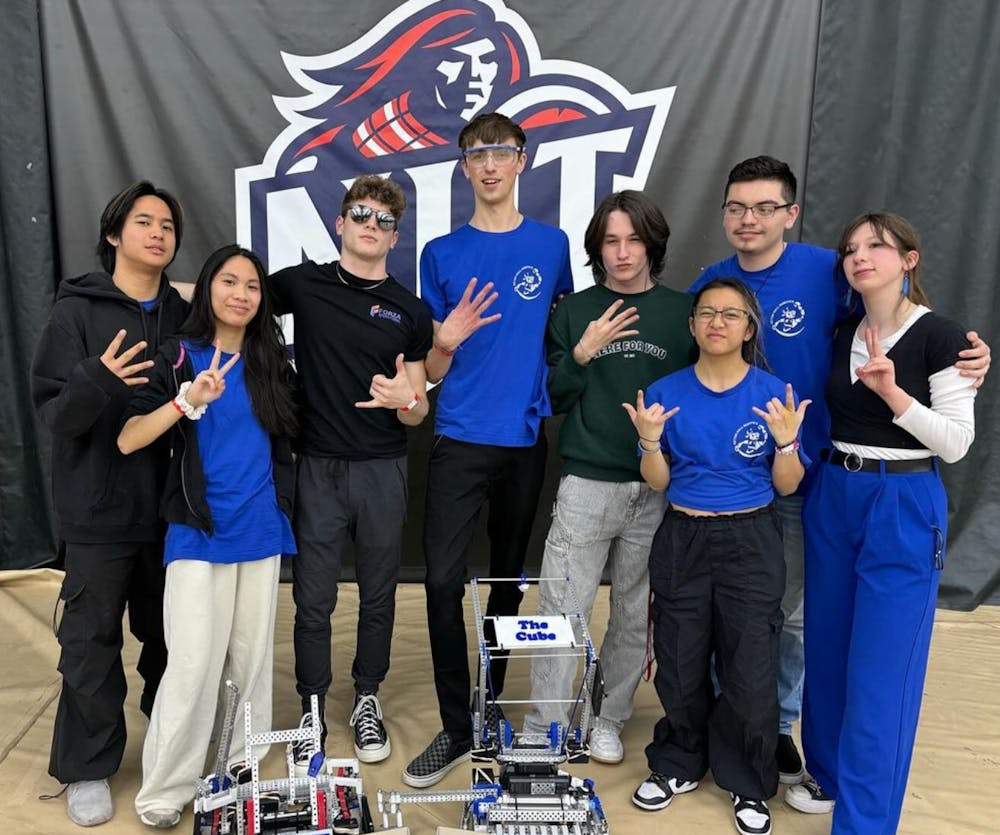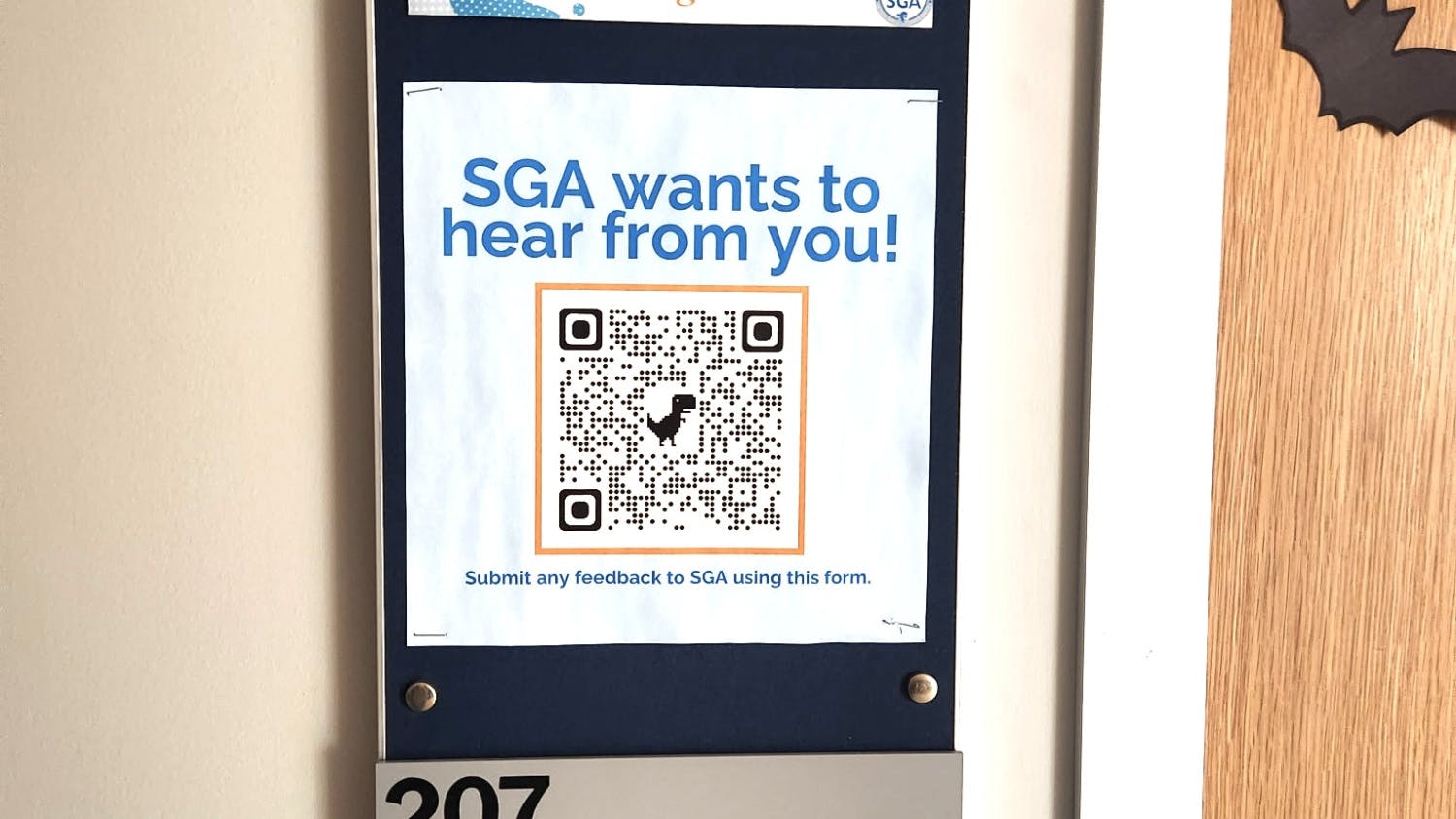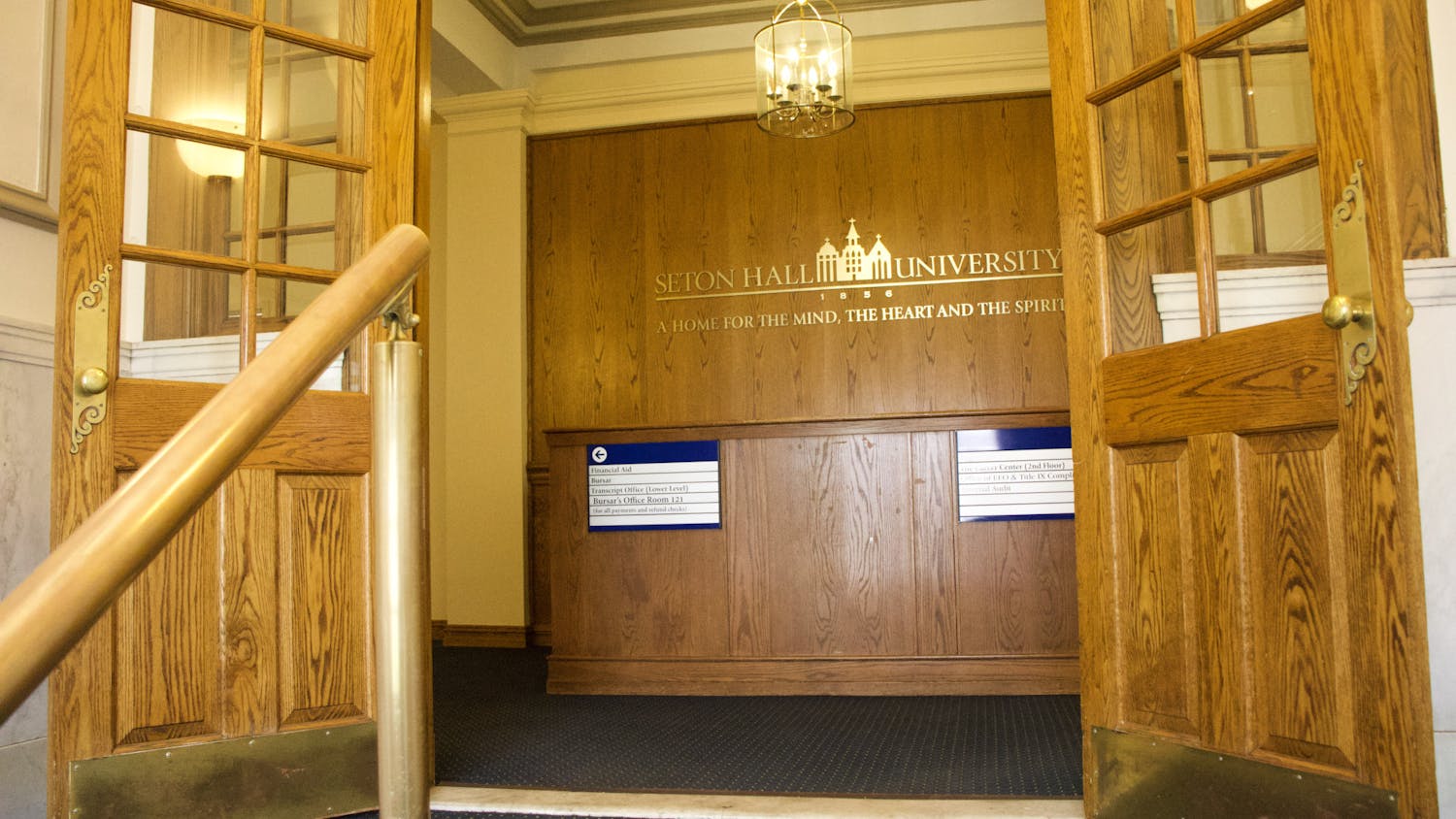The Seton Hall Robotics team advanced to the 2024 VEX Robotics World Championships in Dallas, Texas.
In their first full competitive season, the 13-person team won second place in a competition over spring break at the New Jersey Institute of Technology (NJIT) under the guidance of advisors Erie Morales, Ph.D., and Mehmet Alper Sahiner, Ph.D. The team placed only behind Rochester Institute of Technology with a robot the Seton Hall team named “Big Steppa.” They also won the Robot Skills and Energy awards.
Founders Ayden Frechette, president of the club, and Shane Fusco, vice president, pitched the idea of having a robotics team on a physics club trip to EAG Laboratories. The club got up and running in October 2022, but they didn’t receive their supplies until February of the next year.
“We really scrambled within a month, and then we went to NJIT on March 4, 2023,” said Frechette, a junior in the dual B.S., Physics/M.S., Engineering program in partnership with Stevens Institute of Technology. “So, at that competition we weren’t competitive, really, but we did win the judges award as kind of a perseverance thing. The best team doesn’t get the judges award but that was okay because it was a great achievement to be able to come home with silverware.”
Once the semester ended, the team took time off for the summer and then got back to work in the fall, recruiting more members and preparing for their first competition on February 3 at Vaughn College. Although the team made tangible improvements, they came back to SHU, regrouped, and won second place at NJIT over spring break.
“Winning Best Team Spirit at NJIT was a cool one to get as well because we really did deserve it,” Frechette said. “We did a lot of things that other teams didn’t do, like plaques on our robots with their names, so we kept the fun in it this year which was good.”
In regard to team spirit on the SHU robotics team, Jocelyn Buendia, a freshman physics major also in the dual degree physics program with Stevens, enjoys working with her teammates to problem solve in “stressful and tense” moments during competitions.
“Not only do I get to compete with my friends and teammates, but I get to feel the rush of running from match to match and being able to find solutions to any issues we run into with the robots,” Buendia said. “To me, maintaining the robots during competitions is more than just using screwdrivers and filling pneumatic tanks. It’s about being resourceful with the materials around you to ensure the robot’s features still function.”
Similar to Buendia, Edwin Baiden, treasurer and another founder of the club, takes pride in the way his team works together.
“My experience with the robotics team has been really rewarding,” said Baiden, a junior in the dual degree physics program with a minor in applied scientific math. “It’s a great group of people who are all passionate about what they're doing. Everyone is always willing to help out and share their knowledge, which makes for a great learning environment. It’s been a lot of fun working on projects together and seeing our ideas come to life.”
Justine Fallurin, a freshman double majoring in secondary special education and mathematics, was eager to join SHU robotics after participating in robotics in middle school and volunteering to teach robotics during summers in high school.
“Going into college I wanted to take it a step further and see what it was like on a competitive level,” Fallurin said. “What also drew me in was the nature of the club. They’re competitive but chill in terms of being understanding that it’s a new experience for most people.”
Calling the experience a “whirlwind,” Alexandra Carroll, a freshman diplomacy major, discussed how difficult finding a balance between robotics and other commitments can be, but also how worthwhile it is for her.
“I’m really glad that I stuck through it,” Carroll said. “Last semester was very hard for me between school, other extracurriculars, and personal stuff. I stopped going [to meetings] for a few weeks. When I came back people realized that I was back and it was that aspect of people knowing who I was, knowing that I did work on stuff, and being glad that I was back that really helped me stay.”
Big Steppa was the robot name on everyone’s lips at NJIT this March. To create such a complex machine, certain skills are involved, according to David Garcia, a freshman in the dual degree physics program.
“Big Steppa was a bit of a challenge at first,” Garcia said. “After our first competition, we knew the launching mechanism wasn’t going to work, so I was able to convert it into the climbing mechanism we have now. Instead of launching the tri-balls, it now flicks them out of the Load Zone using a simple arm that swings down. I still love how having such a big robot allows us to be the boss of the Match Field.”
That power comes from the astounding eight motors used to push other teams’ robots out of Big Steppa’s way. Fusco discussed the improvements SHU has made to their robots in detail.
“Big Steppa is the robot that I drive,” said Fusco, a junior physics major. “The whole kind of reason behind that name is it’s the bigger chassis out of the two robots [the other robot being ‘The Cube’]. It’s 24 inches by 24 inches. The whole process behind it really started with the drivetrain, which is actually what allows the robot to move. We told two students, ‘This is the size it needs to be, we want it to have an eight-motor drivetrain,’ which at the time was a lot of motors for us; we had four on the drivetrain last year. So, we’re still going up. And then we started building on top of that.”
Competing involves playing in a “miniature soccer” game of sorts, according to Fusco. In the last 30 seconds of the game, each robot is allowed to elevate off the ground. The higher the robot is, the more points the team gets. SHU robotics also adds their own personal touches to their bots, making the team stand out from their challengers even more.
“I came up with the idea to fabricate a custom sled on the front of the robot,” Fusco said. “I carved ‘Big Steppa,’ ‘Don’t hate the player, hate the game,’ and ‘Seton Hall University’ into it. I put a couple stickers on there. The whole overall design of Big Steppa has just been looking at it, seeing what its weak points are, improving on them, and things like painting all of our metal blue for Seton Hall, which isn’t really a functionality improvement but it’s a cool aesthetic improvement.”
While some may think you need coding, engineering, physics, and math knowledge to be on the robotics team, those aren’t the only skills needed to be in the club. Carroll maintains that they certainly aren’t required to join.
“Concerning skills that people should have when they're thinking about joining the team, I think really one of the big things is being open-minded,” Carroll said. “You need to be open-minded to new ideas from other people. You might have the best ideas ever, but you still need to talk to others about them and work through them.”
Frechette agrees, saying that he and Fusco, and one or two other members, had technical experience when they started the club, but the majority of other members had never worked with robotics before.
“You just have to be willing to get your ideas shot down, you have to be able to accept the fact that your idea may not work, move on, and think of a better one,” Frechette said. “All you have to do is be interested and show up. If you do that, you’ll learn the rest as you go.”
Carroll added that not everyone has science or engineering skills, and that’s okay. With how many things go on behind the scenes, anyone can contribute valuable time and energy to the robotics team.
“If you're good at finance and managing money, we want you,” Carroll said. “If you're good at designing or writing, we want you. And if you just want to have fun, we also want you! Compared to a lot of other teams on the circuit, I would say that we’re pretty laid-back. I think a lot of people are kind of scared off by robotics because they're like, ‘Oh, I can't do that. I'm not smart enough.’ You don't have to be ‘smart’ enough. You just have to be imaginative.”
While Frechette and Fusco are focusing on the championship, which will begin on April 25, they are also looking to the future of SHU robotics. Frechette looked back on starting a robotics club in high school that wasn’t able to develop after he graduated, which he says is one of his biggest fears with SHU’s robotics team.
But he has confidence in the team’s e-board for next year in making the robotics club a permanent fixture on campus. The new e-board will include Fusco taking over Frechette’s role as president. Next year, with Fusco at the helm, he wants to give a voice to engineering and STEM at SHU.
“Most people don’t even know that there’s a physics department here, and there’s no engineering at Seton Hall, so one of our other things when we started the team was to bring more diversity in engineering to the school,” Fusco said. “I come from a family that’s been doing engineering for 20-30 years. I love the field, and I think more people should be exposed to it here. I’m working on bringing in funding from the state to get us engineering kits and labs that can help students learn more about it.”
In terms of what the team members are looking forward to at worlds, Buendia knows how instrumental the championship will be in cementing SHU robotics’ climb.
“I’m most looking forward to competing at such a large event with all my friends because I know how hard we all worked to get here, and how excited everyone is to travel,” Buendia said. “For the future of SHU Robotics, this is an amazing opportunity to put us on the map!”
Frechette “doesn’t have the words to describe” just how “proud” he is of his team, and he’s excited to see what’s to come.
“I have no reason to believe that we can’t compete and we can’t win,” Frechette said. “I’ve watched film of some of the reigning champions of VEX Worlds, and we can be up there as long as we put in the time. And beyond, for me, it’s just making this something that’s going to be here in 10 years.”
The robotics team is currently borrowing the CyberX lab, but they’re fundraising for their own robotics laboratory. With a permanent location at SHU, they can cement their organization on campus and build a space with advanced 3D printing, machining, and programming capabilities. To donate to the cause or learn more, click here!
Jacqueline Litowinsky is a writer for the Setonian’s News section. She can be reached at jacqueline.litowinsky@student.shu.edu.





